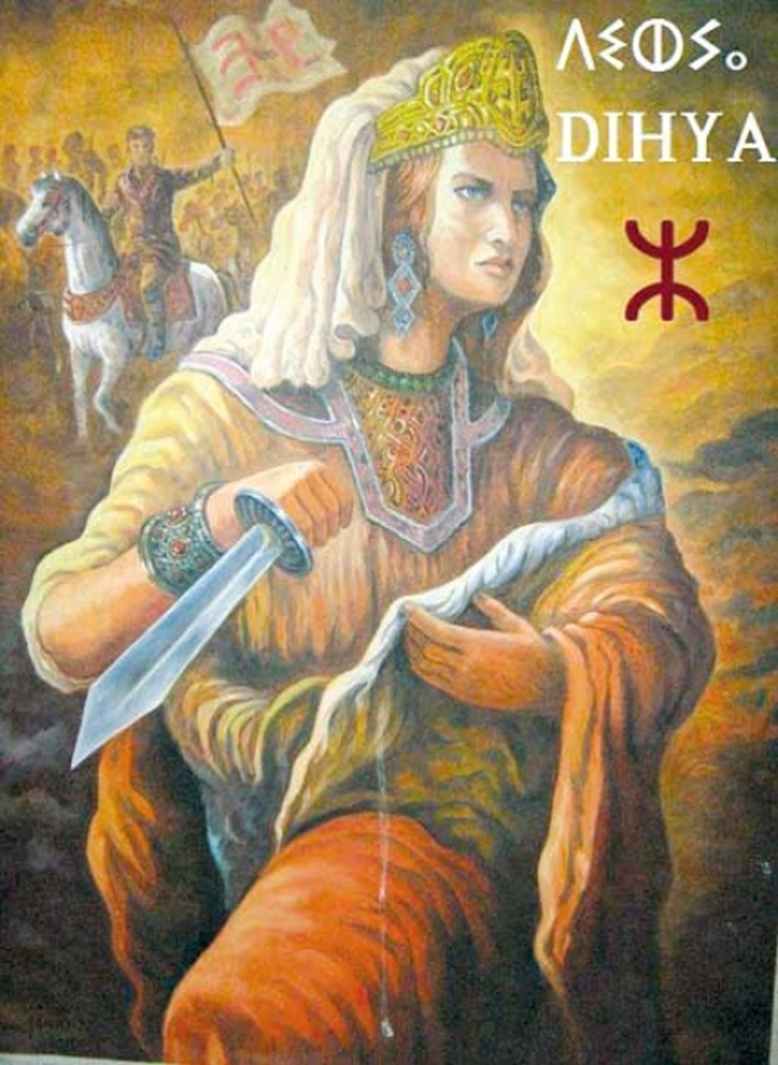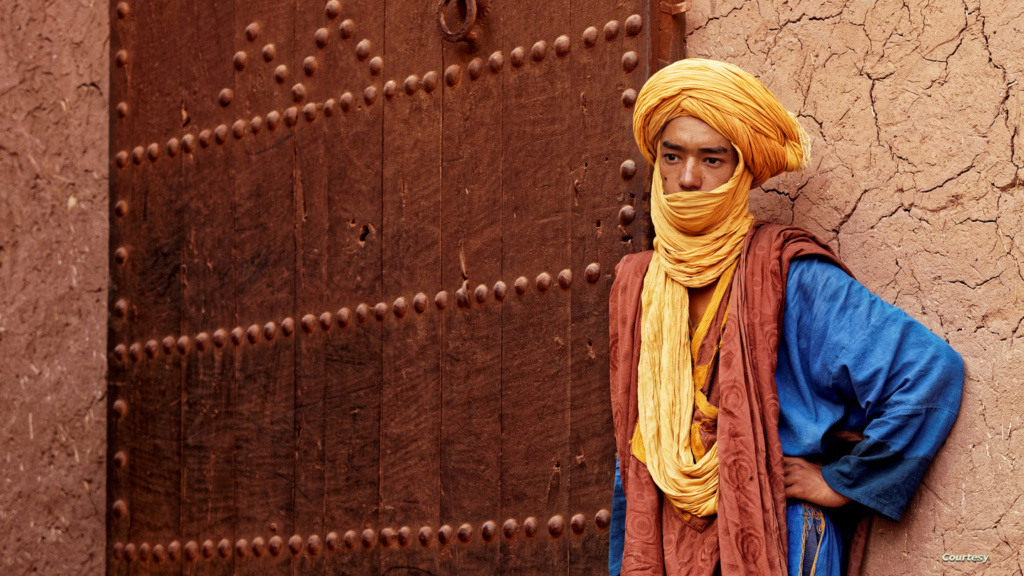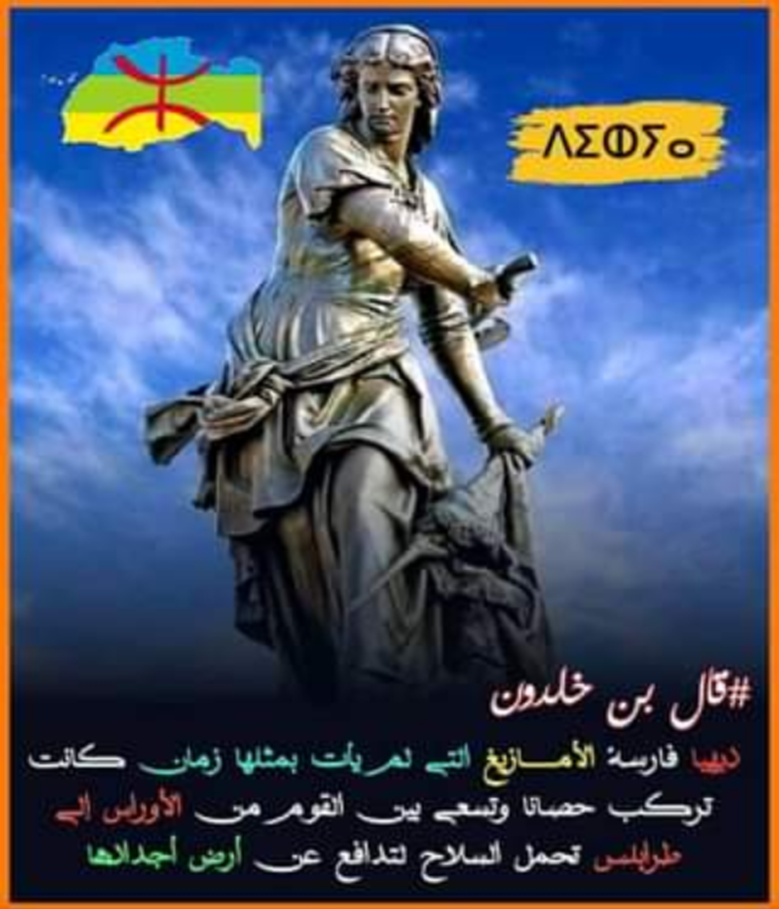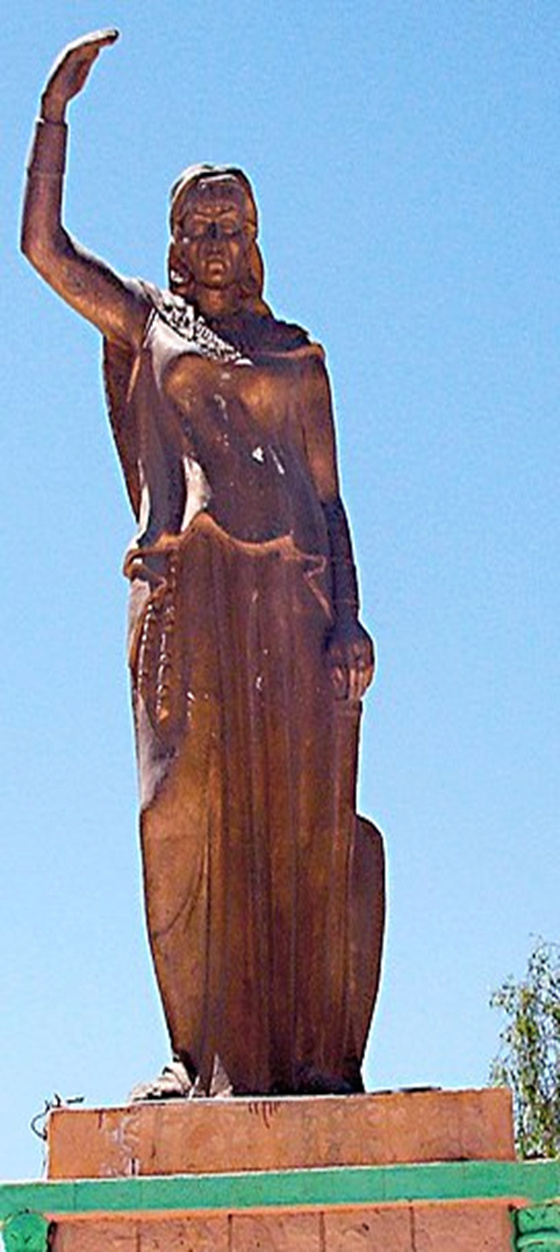?Amazigh Dihya.. Sovereign or Priestess

A symbolic image of the priestess Dehia with the national flag of the Amazighs in the background
In the 7th century AD, the Arab army crawled into North Africa. The purpose of the desert monsters was one: to devour more lands of the Byzantine Empire to spread Islam by shedding the blood of the innocent and taking their wives as captives and their children as slaves and seizing their property. The new doctrine played the role of fuel in the wars of the Muslims against two failing empires at the end of the 7th century: the Romans and the Persians.
Despite the great religious fervor of the Arab armies, their conquest of North Africa was repeatedly hampered by bitter internal disputes between Ali's Shiites and Mu'awiya's supporters over the caliphate. Imam Ali was killed in 661 AD, the year the kingdom settled into Muawiya's hands, but Islamic State's borders to the west stopped at Libya's Cyrenaica region.

In the year 688 AD, Caliph Abd al-Malik Ibn Marwan resumed the Arab invasions to bring the conquered peoples to their knees. Arab leader Hassan bin Al-Numan led the invasions of North Africa. In a short time, he was able to occupy the city of Kairouan and expel the remnants of the Byzantines from Carthage. However, his army suffered a catastrophic defeat against soldiers led by a fierce fighter who crowned the Amazighs of the Aurès Mountains (today in Algeria) on their throne.
Her name is Dihya, but Arabic stories called her the “priestess”. In 689 AD, this strong woman was able to unite the scattered Berber tribes to repel the Arab armies. Despite her victory, reported by Arab historians, such as Al-Waqidi and Ibn Khaldun, in terms where the real mixes with the mythical, five years later, this queen suffered a tragic fate.
?A Jewish woman leads the Amazighs
The Arab historian Abd al-Rahman Ibn Khaldun believed that part of the Amazighs of North Africa were Jews. Their origins are due to a mixture of Phoenician and Canaanite peoples. And in other places in his enormous volume "The Lessons", he goes on to say that some of them warn against the Yemeni kingdom of Himyar (110 BC - 527 AD).

Ibn Khaldun returns, in other chapters, to speak of a courageous Jewish queen who led the Amazigh Jarawa tribe to defeat the Arabs. He says: "The Zanata were the largest of the Amazigh tribes and the most numerous and warring, and the house of Jarawa among them was at Mount Auras (..) and their direction was for the priestess, Dahaba, a daughter ( .. ) and she had three sons. They inherited the leadership of their people from their predecessor, and they were raised in his lap.
And he adds: "When the gathering of the Amazighs ended and Kusaila(aksel) (a Amazigh king who was killed by the Muslim army) was killed, they returned to this priestess on her mount from the Auras mountain, and the Banu Ifran came to her, and whoever was in Ifriqiya from the Zanata tribes and the rest of the amputations, so I met them (the Arabs) in the carpet in front of her mountain and the Muslims were defeated.And I will send their footsteps in its masses until I bring in Ifriqiya (Tunisia).
Regarding the reason for calling her the priestess, Ibn Khaldun believes that Dihya "had fortune telling and knowledge of the unseen conditions of her people, which caused her to assume her throne." However, other historians believe that the Arabs tried to "understate" her victory over them by accusing her of sorcery and sorcery, when she rightfully ascended the throne with the votes of the Tribal Council. (an ancient Amazigh tradition) and reigned for 35 years.

As for the famous Israeli historian Shlomo Sand, he believes that the Amazighs of North Africa were non-Orthodox Jews, and for this they were given a religious rank, which contradicts Jewish rabbinical teachings. He adds, "She was a strong woman, and despite attempts to discredit her, Arab historians have recorded her courage against the invaders."
And the first person to imprint the name "Priestess Dehya" in the mind was the historian specializing in the study of the Jews of North Africa, Nahum Slouches (1872-1966). In 1909, he published two articles on Amazigh Jews, while he published an entire article on the ethnic origin of the priestess. Slouches believes Amazigh Jews came in large numbers from Jerusalem to North Africa, adding that “the priestess was a fighting queen and her origins are Jewish.”

Amazigh clothing in dry areas
In 1939, this historian wrote a book titled "Dihia the Priestess", emphasizing for the first time that her Jewish name is "Judith the Priestess", and since the name Cohen means the priest, her name comes from the root of the word "priestess". ". He adds: "Even his people, Jarawa, are of Jewish origin, and their real name is Gera. They are the people of Israel who come from Egypt to North Africa via Libya."
Slouches is also the first to describe Queen Dihya: "A seductive and strong woman. Beautiful as a horse and as strong as a gladiator." Then later he compared her to the icon of the French army during the Hundred Years War (1337-1453) Joan of Arc. Of her life, Slouches says, "She fell in love with all her might and was married three times."

On the other hand, the Israeli historian Haim Hirshburg (1903-1976) believes that the Amazighs of North Africa converted to Judaism, and are not a purely Jewish race. And he cut off the conclusions of Nahum Slouches that the Jews came from Jerusalem, and also denied the hadith of Ibn Khaldun that the origin of the Amazighs comes from the ancient Himyarite kingdom.
Hirshburg has a completely different theory on the origin of the Priestess. He says in his book "History of the Jews of North Africa": "His name is not Jewish, and there is no allusion to his name. His name is Kahiya, and the Arab writers have it wrong lu, so they wrote the priestess instead of Kahiya."
tragic fate
After Queen Dihya's victory over the Arabs in the Battle of the Aurès Mountains, what was left of Hassan ibn al-Nu'man's army retreated to Libyan Cyrenaica. Dihya was aware that the defeat was temporary, as Hassan ibn al-Nu`man would not stop until he conquered the rest of the Maghreb. Indeed, five years did not pass until the Arabs returned with a huge army.
Shlomo Sand says Dehya relied on a scorched earth policy in this dangerous war. "She knew the Arabs were looking for booty, so she burned the villages, towns and agricultural crops on the coast, while she retreated west, away from the Arab armies."
In 694 AD, the soldiers of Dehya were crushed by the enormous numerical strength of the Arab armies and the modernity of their war machines. Dihya was killed in a place now called "Bir al-Kahina" and her head was taken to the Caliph of the Muslims, while two of her sons joined the Arab army, according to Ibn Khaldun.
History has not preserved much about Dehya, but Arab historians such as Al-Waqidi, Ibn Abd al-Hakam and Ahmad al-Baladhuri have reported different accounts of the heroine. This Amazigh character slept in the burials of books until French colonialism arrived in North Africa and raised it from its ashes.

Ahwash dance in Morocco
Shlomo Sand says, "During the colonial period, French writers revived this forgotten Amazigh Jewish queen from the history books," adding that the purpose of recycling the Dehya myth is "an attempt to woo the Amazighs and show the Arabs as invaders who occupied North Africa by force, and as a result they faced fierce resistance from the Aborigines."
French historian and politician Ernest Mercier offered another version of the battle in which the priestess was killed, implying that "France is the one who will liberate the Amazighs from the Arab occupier".
In her article titled "The Priestess: The Amazigh Face of History", Santia Baker, an expert in Amazigh history at Boston University, states: "Since the 19th century, narratives about the priestess have been rewritten, invoked and modified by various political groups to defend their causes”.

Indeed, the priestess has been used by Israeli writers to talk about the extension of the ancient kingdom of Israel and the spread of Judaism in North Africa, while Arab nationalism and Amazigh pressure groups employed to defend its cultural and historical rights in the land of Israel. the ancestors.
Indeed, the priestess has been used by Israeli writers to talk about the extension of the ancient kingdom of Israel and the spread of Judaism in North Africa, while Arab nationalism and Berber pressure groups employed to defend its cultural and historical rights in the land of Israel . the ancestors.
The Algerian writer Kateb Yassin, one of those who tried to rewrite the legend of the priestess, according to his ideological perception of North Africa. Like other Amazigh intellectuals, Yassine stands up to his people, whose identity has been "lost" among historical empires. And when he couldn't find anyone to hold him accountable for this broken identity, he found the priestess as the last icon who could protect this culture from marginalization and extinction.

Algerian novelist Kateb Yassine
He says in a poem from his book “The Two Thousand Years War”:
First Knight: For the last time, listen, Priestess, Queen of the Amazigh...
Dihya (to the farmers): They call me priestess and they call us barbarians, as the Romans called our ancestors.
Barbarians, barbarians is the same word, just like the rest of the invaders. They call the peoples they oppress barbarians, on the pretext that they want them to be civilized, while they plunder our land.
The queen is alive in the heart
Despite all that has been said about the Arab accounts concerning the priestess, her name would not have gone down in history if not for the Arab journalists. Despite what accompanied the mention of this Amazigh queen, most testimonies agree on the existence of this character, who has become in recent years an icon of the struggle of the Amazighs for the recognition of their culture.

Historian Santia Becker says, "The priestess became a popular figure among Amazigh activists in North Africa. They erected a statue to commemorate her in Algeria (...) The priestess came to symbolize Amazighs as as people who refuse subjugation. They are free and ready to fight for freedom against foreign invaders."
Feminist movements also in the Third World have used the priestess as a symbol of women's power, as well as the relentless struggle for gender equality. During the second half of the last century, the painting of the priestess by the French orientalist and artist Ippolit Leconte (1781-1857) became the image imprinted in the minds of admirers of this historical figure.
Amazigh Queen Dihya
The painting shows a standing woman with her bare arm symbolizing strength, while glancing sideways as if assessing the magnitude of the threat from the east. “Her red robes are a sign of courage and sacrifice, and her jewelry is of local Berber style. In the background is an arid desert environment,” says Santia Baker, adding, “This painting reveals the typical images and patterns that orientalists carried around the region, but that did not stop Amazigh activists from recreating the production of this painting in the form of images that fill forums and websites to confirm the courage of the Amazigh woman and its capacity for political leadership, before the introduction of Islam in the region.
In 2003, amazigh activists in the municipality of Baghaei in Algeria's Aurès region called on the government to restore the ruins of a local castle, which they attributed to the priestess, as she tried to prevent Arab armies to advance and occupy the Aures. .

In the same year, the Oras Priestess Association erected a 1.80 centimeter tall statue of their national heroine in the center of Bagai Municipality. Algeria's School of Fine Arts designed this huge statue, to portray Dehia as a strong woman in bold sleeveless clothing, while raising her right arm in the air, as a symbol of defiance . Algerian President Abdelaziz Bouteflika, at the time, attended the statue's installation ceremony, in a move the media saw as an attempt by the government to appease Amazigh militants in the region.
Source: websites

